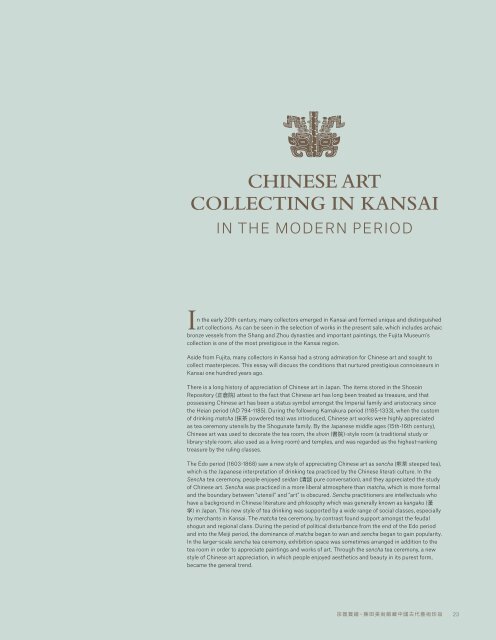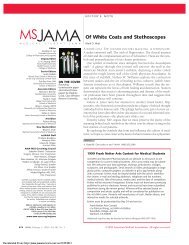SPECIALISTS AND SERVICES FOR THIS AUCTION
NYR14319_SaleCat
NYR14319_SaleCat
Create successful ePaper yourself
Turn your PDF publications into a flip-book with our unique Google optimized e-Paper software.
CHINESE ART<br />
COLLECTING IN KANSAI<br />
IN THE MODERN PERIOD<br />
In the early 20th century, many collectors emerged in Kansai and formed unique and distinguished<br />
art collections. As can be seen in the selection of works in the present sale, which includes archaic<br />
bronze vessels from the Shang and Zhou dynasties and important paintings, the Fujita Museum’s<br />
collection is one of the most prestigious in the Kansai region.<br />
Aside from Fujita, many collectors in Kansai had a strong admiration for Chinese art and sought to<br />
collect masterpieces. This essay will discuss the conditions that nurtured prestigious connoisseurs in<br />
Kansai one hundred years ago.<br />
There is a long history of appreciation of Chinese art in Japan. The items stored in the Shosoin<br />
Repository ( 正 倉 院 ) attest to the fact that Chinese art has long been treated as treasure, and that<br />
possessing Chinese art has been a status symbol amongst the Imperial family and aristocracy since<br />
the Heian period (AD 794-1185). During the following Kamakura period (1185-1333), when the custom<br />
of drinking matcha ( 抹 茶 powdered tea) was introduced, Chinese art works were highly appreciated<br />
as tea ceremony utensils by the Shogunate family. By the Japanese middle ages (15th-16th century),<br />
Chinese art was used to decorate the tea room, the shoin ( 書 院 )-style room (a traditional study or<br />
library-style room, also used as a living room) and temples, and was regarded as the highest-ranking<br />
treasure by the ruling classes.<br />
The Edo period (1603-1868) saw a new style of appreciating Chinese art as sencha ( 煎 茶 steeped tea),<br />
which is the Japanese interpretation of drinking tea practiced by the Chinese literati culture. In the<br />
Sencha tea ceremony, people enjoyed seidan ( 清 談 pure conversation), and they appreciated the study<br />
of Chinese art. Sencha was practiced in a more liberal atmosphere than matcha, which is more formal<br />
and the boundary between “utensil” and “art” is obscured. Sencha practitioners are intellectuals who<br />
have a background in Chinese literature and philosophy which was generally known as kangaku ( 漢<br />
学 ) in Japan. This new style of tea drinking was supported by a wide range of social classes, especially<br />
by merchants in Kansai. The matcha tea ceremony, by contrast found support amongst the feudal<br />
shogun and regional clans. During the period of political disturbance from the end of the Edo period<br />
and into the Meiji period, the dominance of matcha began to wan and sencha began to gain popularity.<br />
In the larger-scale sencha tea ceremony, exhibition space was sometimes arranged in addition to the<br />
tea room in order to appreciate paintings and works of art. Through the sencha tea ceremony, a new<br />
style of Chinese art appreciation, in which people enjoyed aesthetics and beauty in its purest form,<br />
became the general trend.<br />
23



